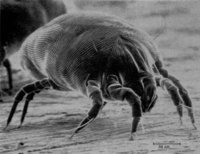House dust mite
|
|
| House dust mite Conservation status: Secure | ||||||||||||||
|---|---|---|---|---|---|---|---|---|---|---|---|---|---|---|
 | ||||||||||||||
| Scientific classification | ||||||||||||||
| ||||||||||||||
| Binomial name | ||||||||||||||
| Dermatophagoides pteronyssinus |
The house dust mite (Dermatophagoides pteronyssinus in Europe and Dermatophagoides farinae in North America), sometimes abbreviated by allergists to HDM, is a cosmopolitan guest in human habitation, gaining scientific prominence only in the 1600s after the importance of sanitation was recognized. They are considered to be one of the most common causes of asthma worldwide.
Description
Both male and female adult house dust mites are globular in shape, creamy white and have a striated cuticle. The female measures approximately 420 micrometres in length and 320 micrometres in width. The male is approximately 420 micrometres long and 245 micrometres wide. A member of the phylum Arthropoda, house dust mites have eight legs.
The average life cycle for a male house dust mite is approximately 19-30 days while a mated female house dust mite can live for up to two months, laying eggs for the last 30 days of her life.
Habitat
The house dust mite is more common in Europe than North America. The mite thrives in the modern environment of fully-carpeted, double-glazed, draft-proof homes, and is comfortable at 25 degrees Celsius and 75% relative humidity. The mites are particularly common in carpets and bedding.
The mite generally lives on shed human skin cells, which are pre-digested by the fungus Aspergillus repens. An average person sheds about 1.5 grams of skin a day (approximately 3-4.5 kg per year), which is enough to feed roughly a million dust mites. Further, dust mites in bedding derive moisture from human breathing, perspiration, and saliva.
Asthma
The house dust mite is one of the most significant allergens, implicated in allergic asthma, rhinitis, conjunctivitis and dermatitis. The protein responsible for the allergic reaction is DerP1, a protease digestive enzyme found in mite feces.
Measures to control house dust mites:
- Do not use a vacuum cleaner (bags and bagless are dust blowing tools)
- Regular damp dusting of surfaces
- Replacement of carpets with vinyl flooring
- Covering of mattresses and pillows with impervious materials
- Daytime internment of children's plush toys in a freezer
- Use of chemicals to kill mites (acaricides)
- Use of fungicides to kill Aspergillus
- Use an FDA approved air filtration & cleaning system (especially with high-efficiency particulate air (HEPA+ filtration)
- Reduce ambient humidty below 70% to inhibit growth of Aspergillus
Though these methods can help to reduce the level of house dust mites, attempts to eradicate homes completely have yet to be successful. Immunotherapy, in the form of injections of the allergen into patients, has been successful for some in much the same way that "allergy shots" have been helpful for sufferers of hayfever.
